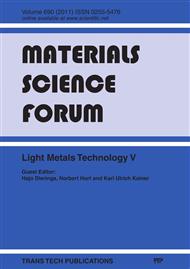p.7
p.11
p.15
p.21
p.25
p.29
p.33
p.37
p.41
The Application of Positron Emission Particle Tracking (PEPT) to Study Inclusions in the Casting Process
Abstract:
The behavior of inclusions in castings was studied using radioactive labeling of oxide particles located by Positron Emission Particle Tracking (PEPT). This uses the isotope 18F, which has a half-life of 110 minutes, and allows particle detection within an accuracy of a few mm. Alumina and glass particles with a size range of 110 to 600 μm were made radioactive by an ion-exchange/surface adsorption process involving irradiated water. Individual radioactive particles were placed in resin-bonded sand moulds at known initial positions, and the moulds were filled with Al alloy, causing the particle to be entrained into the metal stream during the casting process. A modular γ-ray positron camera was used to track the paths of the particles within the mould, demonstrating the applicability of the technique to the study of inclusion behaviour in castings.
Info:
Periodical:
Pages:
25-28
Citation:
Online since:
June 2011
Keywords:
Price:
Сopyright:
© 2011 Trans Tech Publications Ltd. All Rights Reserved
Share:
Citation:


